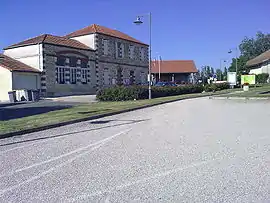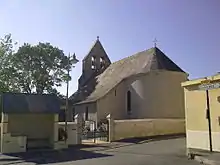Barinque | |
|---|---|
 The Town hall and School | |
Location of Barinque | |
 Barinque  Barinque | |
| Coordinates: 43°24′28″N 0°16′15″W / 43.4078°N 0.2708°W | |
| Country | France |
| Region | Nouvelle-Aquitaine |
| Department | Pyrénées-Atlantiques |
| Arrondissement | Pau |
| Canton | Pays de Morlaàs et du Montanérès |
| Government | |
| • Mayor (2020–2026) | Sylvie Larrochelle[1] |
| Area 1 | 9.00 km2 (3.47 sq mi) |
| Population | 589 |
| • Density | 65/km2 (170/sq mi) |
| Time zone | UTC+01:00 (CET) |
| • Summer (DST) | UTC+02:00 (CEST) |
| INSEE/Postal code | 64095 /64160 |
| Elevation | 194–284 m (636–932 ft) (avg. 270 m or 890 ft) |
| 1 French Land Register data, which excludes lakes, ponds, glaciers > 1 km2 (0.386 sq mi or 247 acres) and river estuaries. | |
Barinque (French pronunciation: [baʁɛ̃k]; Occitan: Barinco) is a commune of the Pyrénées-Atlantiques department in the Nouvelle-Aquitaine region of south-western France.[3]
Geography
Barinque is located on a steep hill overlooking the Souye valley, some 15 kilometres north-east of Pau and 7 km south-east of Auriac in the Vic-Bihl region. Access to the commune is by the D222 road from Higuères-Souye in the south which goes north through the west of the commune to the village then continues east to join the D43 which forms the south-eastern border of the commune as it goes from Escoubès in the east to Saint-Jammes in the south. There are large areas of forest in the south of the commune and scattered forests in the commune however most of the commune is farmland.[4]
The Luy de France flows from the south forming the entire western border of the commune before continuing north to eventually join the Luy north of Castel-Sarrazin. The Souye river flows from south to north-west through the heart of the commune joining the Luy de France on the western border of the commune. The Ruisseau de Cimpceu rises east of the village and flows north to join the Gabas west of Sévignacq.[4]
Places and Hamlets
Below is a list of places and hamlets in the commune:[5]
- Antoni
- Arnaud
- Artigou
- Auguste
- Barbe
- Barthe
- Bié
- Bourdallé
- Castagnet
- Champrilh
- Charron
- Coulate
- Daguet
- Fisse
- La Gare
- Garimbay
- Gélizé
- Grabette
- Jeanbounat
- Labat
- Laragnou
- Lardas
- Lasalle
- Lauga
- Lavigne (2 places)
- Loudet[6]
- Loustau
- Margotou
- Mariette
- Marque
- Mingenette
- Monge
- Mouchou
- Parjouan
- Pébrocq
- Picou
- Pierrot[7]
- Piot
- Piquet
- Pisseu
- Portaix
- Prétou
- Prince
- Pucheu
- Saubade[8]
- Soubirou
- Toulardet
Toponymy
The commune name in béarnais is Barinco (pronounced Barincou). Michel Grosclaude concluded that the name is of Occitan origin with the meaning "slope towards a ravine",[9] following Dauzat and Rostaing who offered a Gaulish and pre-Gaulish root barr- meaning "height" or "summit" with the suffix -incum.[10]
The following table details the origins of the commune name and other names in the commune.
| Name | Spelling | Date | Source | Page | Origin | Description |
|---|---|---|---|---|---|---|
| Barinque | Barinco | 1385 | Grosclaude | Village | ||
| Barinco | 1402 | Raymond | 21 | Census | ||
| Barincquo | 1538 | Raymond | 21 | Reformation | ||
| Barinquo | 1542 | Raymond | 21 | Barinque | ||
| Barincou | 1676 | Raymond | 21 | Reformation | ||
| Barrinque | 1801 | Raymond | 21 | Bulletin des lois | ||
| Sansous | Sansous | 1385 | Raymond | 156 | Census | Farm |
Sources:
- Grosclaude: Toponymic Dictionary of communes, Béarn, 2006 (in French)[9]
- Raymond: Topographic Dictionary of the Department of Basses-Pyrenees, 1863, on the page numbers indicated in the table. (in French)[11]
- EHESS: Des villages de Cassini aux communes d'aujourd'hui: Commune data sheet Barinque, EHESS (in French).
Origins:
History

Paul Raymond noted on page 21 of his 1863 dictionary that Barinque had a Lay Abbey, vassal of the Viscounts of Béarn. In 1385 Barinque had 15 fires and depended on the bailiwick of Pau.[11]
Barinque was part of the Barony of Navailles in the Middle Ages.[15]
The commune was part of the Arch-Deaconry of Vic-Bilh which depended on the Bishop of Lescar and Lembeye was the capital.[11]
Barinque appears as Barinque on the 1750 Cassini Map[16] but as Barringue on the 1790 version.[17]
Administration
| From | To | Name |
|---|---|---|
| 1900 | 1929 | Alphonse Castagnet |
| 1929 | 1931 | Bernard Millet |
| 1931 | 1944 | Guillaume Piot |
| 1944 | 1945 | Jean Laborde-Loustau |
| 1945 | 1947 | Guillaume Piot |
| 1947 | 1977 | Jean Laborde-Loustau |
| 1977 | 2008 | José Laborde-Loustau |
| 2008 | 2020 | Bernard Buron |
| 2020 | 2026 | Sylvie Larrochelle |
Demography
The inhabitants of the commune are known as Barinquais or Barinquaises in French.[19]
|
| ||||||||||||||||||||||||||||||||||||||||||||||||||||||||||||||||||||||||||||||||||||||||||||||||||||||||||||||||||
| Source: EHESS[20] and INSEE[21] | |||||||||||||||||||||||||||||||||||||||||||||||||||||||||||||||||||||||||||||||||||||||||||||||||||||||||||||||||||

Culture and heritage
Civil heritage
The commune has a number of buildings and sites that are registered as historical monuments:
Religious heritage

The Parish Church of Saint-Barthélémy (12th century)![]() is registered as an historical monument.[23] The Church contains many items that are registered as historical objects:
is registered as an historical monument.[23] The Church contains many items that are registered as historical objects:
- The Furniture in the Church
 [24]
[24] - A container for Baptismal water (17th century)
 [25]
[25] - A Collection Plate (19th century)
 [26]
[26] - 6 Candlesticks (19th century)
 [27]
[27] - A Chalice (18th century)
 [28]
[28] - 2 Processional Banners (19th century)
 [29]
[29] - A Mural Painting: Saints Paul and Peter and 2 Angels (16th century)
 [30]
[30] - A Stoup (19th century)
 [31]
[31] - A secondary Altar of the Virgin with Tabernacle and stand for a Monstrance (18th century)
 [32]
[32] - An Altar Painting: the Martyrdom of Saint Barthélémy (1650)
 [33]
[33] - A Retable (1650)
 [34]
[34] - 3 Statuettes: Saint Peter, Saint Paul, and the Virgin with child (1720)
 [35]
[35] - A Tabernacle (1650)
 [36]
[36] - The main Altar and Tomb (18th century)
 [37]
[37] - The main Altar, Tabernacle, and Retable (18th century)
 [38]
[38] - A Stained glass window: Saint John (Bay 2) (1873)
 [39]
[39] - 4 Stained glass windows (Bays 3-6) (19th century)
 [40]
[40] - A Capital and recessed Stoup (13th century)
 [41]
[41]
See also
References
- ↑ "Répertoire national des élus: les maires" (in French). data.gouv.fr, Plateforme ouverte des données publiques françaises. 13 September 2022.
- ↑ "Populations légales 2021". The National Institute of Statistics and Economic Studies. 28 December 2023.
- ↑ INSEE commune file
- 1 2 3 Barinque on Google Maps
- ↑ Barinque on the Géoportail from National Geographic Institute (IGN) website (in French)
- 1 2 Ministry of Culture, Mérimée IA00026900 Farmhouse at Loudet (in French)
- 1 2 Ministry of Culture, Mérimée IA00026901 Farmhouse at Pierrot (in French)
- 1 2 Ministry of Culture, Mérimée IA00026902 Farmhouse at Saubade (in French)
- 1 2 Michel Grosclaude, Toponymic Dictionary of communes, Béarn, Edicions reclams & Édition Cairn - 2006, 416 pages, ISBN 2-35068-005-3(in French)
- ↑ Albert Dauzat and Charles Rostaing, Etymological Dictionary of place names in France, Larousse, Paris, 1963 (in French)
- 1 2 3 Topographic Dictionary of the Department of Basses-Pyrenees, Paul Raymond, Imprimerie nationale, 1863, Digitised from Lyon Public Library 15 June 2011 (in French)
- ↑ Manuscript from the 14th century - Departmental Archives of Pyrénées-Atlantiques (in French)
- ↑ Manuscript from the 16th to 18th centuries - Departmental Archives of Pyrénées-Atlantiques (in French)
- ↑ Titles of Barinque in the Departmental Archives of Pyrénées-Atlantiques (in French)
- ↑ Barinque official website - History page (in French)
- ↑ Barinque on the 1750 Cassini Map
- ↑ Barringue on the 1790 Cassini Map
- ↑ List of Mayors of France (in French)
- ↑ Pyrénées-Atlantiques, habitants.fr
- ↑ Des villages de Cassini aux communes d'aujourd'hui: Commune data sheet Barinque, EHESS (in French).
- ↑ Population en historique depuis 1968, INSEE
- ↑ Ministry of Culture, Mérimée IA00026899 Houses and Farms (in French)
- ↑ Ministry of Culture, Mérimée IA00026903 Parish Church of Saint-Barthélémy (in French)
- ↑ Ministry of Culture, Palissy IM64000497 Furniture in the Church (in French)
- ↑ Ministry of Culture, Palissy IM64000496 Container for Baptismal water (in French)
- ↑ Ministry of Culture, Palissy IM64000495 Collection Plate (in French)
- ↑ Ministry of Culture, Palissy IM64000494 6 Candlesticks (in French)
- ↑ Ministry of Culture, Palissy IM64000493 Chalice (in French)
- ↑ Ministry of Culture, Palissy IM64000491 Processional Banner (1) IM64000492 Processional Banner (2)(in French)
- ↑ Ministry of Culture, Palissy IM64000490 Mural Painting: Saints Paul and Peter and 2 Angels (in French)
- ↑ Ministry of Culture, Palissy IM64000489 Stoup (in French)
- ↑ Ministry of Culture, Palissy IM64000488 Secondary Altar of the Virgin with Tabernacle and stand for a Monstrance (in French)
- ↑ Ministry of Culture, Palissy IM64000487 Altar Painting: the Martyrdom of Saint Barthélémy (in French)
- ↑ Ministry of Culture, Palissy IM64000486 Retable (in French)
- ↑ Ministry of Culture, Palissy IM64000485 3 Statuettes: Saint Peter, Saint Paul, and the Virgin with child (in French)
- ↑ Ministry of Culture, Palissy IM64000484 Tabernacle (in French)
- ↑ Ministry of Culture, Palissy IM64000483 Main Altar and Tomb (in French)
- ↑ Ministry of Culture, Palissy IM64000482 Main Altar, Tabernacle, and Retable (in French)
- ↑ Ministry of Culture, Palissy IM64000481 Stained glass window: Saint John (Bay 2) (in French)
- ↑ Ministry of Culture, Palissy IM64000480 4 Stained glass windows (Bays 3-6) (in French)
- ↑ Ministry of Culture, Palissy IM64000479 Capital and recessed Stoup (in French)